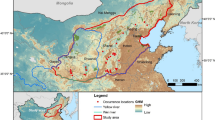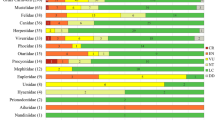Abstract
Ecological niche modeling is particularly valuable for predicting the true and potential distribution of wild birds. The core zone of the Yancheng National Nature Reserve (YNNR) is the largest overwintering habitat of red-crowned cranes in the world. Based on a GF-2 image in 2015 and field data related to micro-habitats of cranes, five functional factors were selected and analyzed with maximum entropy (MaxEnt) and boosted regression tree (BRT) models. The prediction results of the MaxEnt and BRT algorithms reached outstanding levels. Landscape type was the most important environmental factor affecting the habitat quality of overwintering cranes, while distance to water sources was the least contributing factors in both models. The response curve of the BRT was more reasonable than the MaxEnt at explaining habitat selection and utilization by cranes. It revealed that superior habitats are principally distributed in Suaeda salsa in natural wetlands. This habitat currently faces serious fragmentation and islandization. This study evaluates the quality of overwintering habitat for red-crowned cranes based on ecological niche modeling. The results provide a scientific basis for the protection of the overwintering habitat of this species of crane, and it is critical for species protection and management planning of nature reserves.





Similar content being viewed by others
References
Archibald G (1996) Crazy about cranes. Ranger Rick 30:42
Booth TH, Nix HA, Busby JR, Hutchinson MF, Franklin J (2014) Bioclim: the first species distribution modeling package, its early applications and relevance to most current MaxEnt studies. Divers Distrib 20:1–9
Cabral JS, Kreft H (2012) Linking ecological niche community ecology and biogeography: insights from a mechanistic niche model. J Biogeogr 39:2212–2224
Cao MC, Sun XP, Yue ZF, Cui P, Gong X, Xu HG (2016) Analysis of changes in wintering habitat of red-crowned cranes based on MAXENT model. J Ecol and Rural Environ 32:964–970
Deng WH (2009) Habitat fragmentation and bird life. Acta Ecologica Sinica 29:3181–3187
Deng WH, Zheng GM (2004) Landscape and habitat factors affecting cabot’s tragopan Tragopan caboti occurrence in habitat fragments. Biol Conserv 117:25–32
Dong K, Lv SC, Terry H (2005) Carrying capacity of red-crowned cranes in the national Yancheng rare birds Nature Reserve, Jiangsu Province, China. Acta Ecologica Sinica 25:2608–2615
Drew CA, Wiersma YF, Huettmann F (2011) Predictive species and habitat modeling in landscape ecology, 1st edn. Springer, New York
Elith J, Leathwick JR, Hastie T (2008) A working guide to boosted regression trees. J Anim Ecol 77:802–813
Franklin J, McCullough P, Gray C (2000) Terrain variables used for predictive mapping of vegetation communities in Southern California. In: Wilson JP, Gallant JC (eds) Terrain Analysis: Principles and Applications, 1st edn. Wiley & Sons, New York, pp 331–353
Fronczak DL, Andersen DE, Hanna EE, Cooper TR (2017) Distribution and migration chronology of eastern population sandhill cranes. J Wildlife Manage 81:1021–1032
García-Callejas D, Araújo MB (2016) The effects of model and data complexity on predictions from species distributions models. Ecol Model 326:4–12
Guisan A, Thuiller W (2005) Predicting species distribution: offering more than simple habitat models. Ecol Lett 8:993–1009
Guisan A, Tingley R, Baumgartner JB, Naujokaitis-Lewis I, Sutcliffe PR, Tulloch AIT, Regan TJ, Brotons L, McDonald-Madden E, Mantyka-Pringle C, Martin TG, Rhodes JR, Maggini R, Setterfield SA, Elith J, Schwartz MW, Wintle BA, Broennimann O, Austin M, Ferrier S, Kearney MR, Possingham HP, Buckley YM (2013) Predicting species distributions for conservation decisions. Ecol Lett 16:1424–1435
Guo QH, Liu Y (2010) ModEco: An integrated software package for ecological niche modeling. Ecography 33:637–642
Gwenaëlle LL, Engler R, Franc E, Guisan A (2010) Prospective sampling based on model ensembles improves the detection of rare species. Ecography 33:1015–1027
Hall LS, Krausman PR, Morrison ML (1997) The habitat concept and a plea for standard terminology. Wildlife Soc B 25:173–182
Harris J, Mirande C (2013) A global overview of cranes: status, threats and conservation priorities. Chin Birds 4:189–209
Iverson GC, Vohs PA, Tacha TC (1985) Distribution and abundance of sandhill cranes wintering in western Texas. J Wildlife Manage 49:250–255
Jiménez-Valverde A (2012) Insights into the area under the receiver operating characteristic curve (AUC) as a discrimination measure in species distribution modeling. Global Ecol Biogeogr 21:498–507
Li WJ, Wang ZJ (2000) A wintering habitat model for red crown crane. Chin J Appl Ecol 11:839–842
Li WJ, Wang ZJ, Ma ZJ, Tang HX (1999) Designing the core zone in a biosphere reserve based on suitable habitats: Yancheng Biosphere Reserve and the red crowned crane (Grus japonensis). Biol Conserv 90:167–173
Li ZQ, Wang Z, Ge C (2013) Time budgets of wintering red-crowned cranes: effects of habitat, age and family size. Wetlands 33:227–232
Liu HY (2005) Characteristics of wetland resources and ecological safety in China. Resour Sci 27:54–60
Liu HY, Li ZF (2013) Basic theory and technical framework of coastal wetland landscape process model. Chinese J Ecol 32:2815–2822
Liu CY, Jiang HX, Zhang SQ, Li CR, Hou YQ, Qian FW (2013) Multi-scale analysis to uncover habitat use of red-crowned cranes: implication for conservation. Curr Zool 59:604–617
Liu CY, Jiang HX, Zhang SQ, Li CR, Pan X, Lu J, Hou YQ (2016a) Expansion and management implications of invasive alien Spartina alterniflora in Yancheng salt marshes, China. Open J Ecol 6:113–128
Liu DW, Zhang YL, Sun Y, Lv SC, Cheng H, Mu SJ, Lu CH (2016b) Population dynamics and habitat selection of over wintering red-crowned cranes in coastal wetland of Yancheng, Jiangsu Province. J Ecol Rural Environ 32:473–477
Lu N, Jia CX, Lloyd H, Sun YH (2012) Species-specific habitat fragmentation assessment, considering the ecological niche requirements and dispersal capability. Biol Conserv 152:102–109
Lv SC (2009) Relationship between the population dynamics of the wintering Red-crowned Crane in natural reserve for rare birds in beach region and wetland environment variance of Yancheng. J Nanjing Norm Univ 32:89–93
Ma ZJ, Wang ZJ, Tang HX (1999) Habitat use and selection by red-crowned crane (Grus japonensis) in winter in Yancheng Biosphere Reserve, China. Ibis 141:135–139
Ma ZJ, Cai YT, Li B, Chen JK (2010) Managing wetland habitat for waterbirds: an international perspective. Wetlands 30:15–27
Merow C, Smith MJ, Edwards TC, Guisan A, Mcmahon SM, Normand S, Thuiller W, Wüest RO, Zimmermann NE, Elith J (2015) What do we gain from simplicity versus complexity in species distribution models? Ecography 37:1267–1281
Mi CR, Falk H, Guo YM (2016) Climate envelope predictions indicate an enlarged suitable wintering distribution for Great Bustards (Otis tarda dybowskii ) in China for the 21st century. Peer J 4:1630
Millar CS, Blouin-Demers G (2012) Habitat suitability modelling for species at risk is sensitive to algorithm and scale: a case study of Blanding’s turtle, Emydoidea blandingii, in Ontario, Canada. J Nat Conserv 20:18–29
Ou WX, Pang Q, Gan YTT (2014) Wetland use change and its impact on wintering habitats of red-crowned crane in Yancheng coastal wetland. China Popul, Resour Environ 24:30–36
Peterson AT, Soberón J, Richard GP, Robert PA, Martínez-Meyer E, Nakamura M, Araújo MB (2011) Ecological niches and geographic distributions. Monogrs Popul Biol 49:328
Phillips SJ, Dudı´k M (2008) Modeling of species distributions with Maxent: new extensions and a comprehensive evaluation. Ecography 31:161–175
Phillips SJ, Anderson RP, Schapire RE (2006) Maximum entropy modeling of species geographic distribution. Ecol Model 190:231–259
Prasad AM, Iverson LR, Liaw A (2006) Newer classification and regression tree techniques: bagging and random forests for ecological prediction. Ecosystems 9:181–199
Sitters H, Christie F, Stefano JD, Swan M, Collins P, York A (2014) Associations between occupancy and habitat structure can predict avian responses to disturbance: implications for conservation management. Forest Ecol Manag 331:227–236
Su LY, Zou HF (2012) Status, threats and conservation needs for the continental population of the red-crowned crane. Chinese Birds 3:147–164
Sun XB, Liu HY (2011) Temporal changes of Grus japonensis suitable wintering habitat in coastal zone of Yancheng, Jiangsu. Chinese J Ecol 30:694–699
Tanneberger F, Flade M, Preiksa Z, Schröder B (2010) Habitat selection of the globally threatened Aquatic Warbler Acrocephalus paludicola at the western margin of its breeding range and implications for management. Ibis 152:347–358
Wang X, Sun XP, Cao MC, Zhang YL, Zhu MC (2016) A multi-scale approach to investigating the wintering habitat selection of red-crowned cranes in the Yancheng Nature Reserve, China. Pak J Zool 48:349–357
West AM, Evangelista PH, Jarnevich CS, Young NE, Stohlgren TJ, Talbert C, Talbert M, Morisette J, Anderson R (2016) Integrating remote sensing with species distribution models; mapping Tamarisk invasions using the software for assisted habitat modeling (SAHM). J Vis Exp 116:1–9
Xu ZL, Peng HH, Peng SZ (2015) The development and evaluation of species distribution models. Acta Ecologica Sinica 35:557–567
Yu WY, Li ZH, Hua C, Shen YM, Ma L, Guo N, Li ZX (2009) The diversity analysis of macrobenthic fauna on the tidal flat with Spartina alterniflora in Dongtai, Yancheng in Jiangsu. T Oceanol Limn 1:123–128
Zhang HB, Liu HY, Li YF, Hou MH (2013) The coupling relationship between soil eco-processes and landscape evolution under the natural conditions in Yancheng coastal wetland. J Nat Resour 28:63–72
Zhao Y, Zhao GH, Li XM (2014) A preliminary study on foraging habitat of Red-crowned Crane in summer in honghe wetland. Territ Nat Resour Study 1:86–88
Zhu LJ (2009) Quantitative evaluation of habitat edge effects of red-crowned cranes during wintering in Jiangsu coastal wetland of Yancheng. MaD, Nanjing Norm Univ, Nanjing
Zhu GP, Liu GQ, Bu WJ, Gao YB (2013) Ecological niche modeling and its applications in biodiversity conservation. Biodivers Sci 21:90–98
Acknowledgments
We would like to thank Mr. Hao Chen and Shicheng Lv in Yancheng National Nature Reserve for giving us permission to conduct this study.
Funding
This study was supported by the auspices of National Natural Science Foundation of China (No. 31570459, 41771199), Natural science fund in Jiangsu Province (No. 15KJA170002, BK20171277), and a Project Funded by the Priority Academic Program Development of Jiangsu Higher Education Institutions (PAPD).
Author information
Authors and Affiliations
Corresponding author
Additional information
This article is part of the Topical Collection on Geological Modeling and Geospatial Data Analysis
Rights and permissions
About this article
Cite this article
Wang, J., Liu, H., Li, Y. et al. Habitat quality of overwintering red-crowned cranes based on ecological niche modeling. Arab J Geosci 12, 750 (2019). https://doi.org/10.1007/s12517-019-4932-9
Received:
Accepted:
Published:
DOI: https://doi.org/10.1007/s12517-019-4932-9




